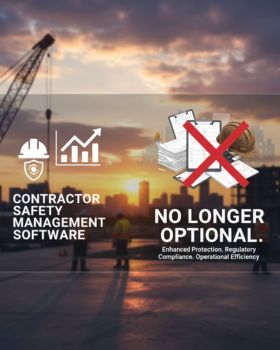
In the construction industry, safety and compliance are paramount. With nearly 1 in 5 worker deaths occurring in this sector, the need for rigorous safety measures cannot be overstated. As construction companies grapple with the challenges of maintaining safety standards, the integration of technology, particularly through contractor management software, is proving to be a game-changer. In this blog, we will explore how contractor software can enhance safety, improve compliance, and ultimately create a more secure work environment for all.
The Importance of Safety in Construction
The statistics surrounding construction safety are alarming. The “Fatal Four”—falls, struck-by incidents, electrocutions, and caught-in/between accidents—account for 65% of all construction-related deaths. Moreover, a staggering 57% of fatal injuries occur in small businesses with fewer than 10 workers. This highlights the urgent need for comprehensive safety training and effective contractor management systems that prioritize safety.
Investing in safety programs is not just a regulatory requirement; it’s also a financially sound decision. Construction companies can save $4 to $6 for every $1 invested in safety programs. This compelling return on investment is one of the many reasons why adopting contractor management software is becoming essential for modern construction businesses.
The Role of Contractor Management Software
Contractor management software streamlines the processes involved in managing contractors, from onboarding to compliance tracking. These systems provide a centralized platform for safety documentation, training schedules, and compliance checklists, making it easier for companies to monitor their safety measures.
- Centralized Safety Documentation
One of the key features of contractor management systems is their ability to centralize safety documentation. This includes safety manuals, training records, and incident reports. By having all safety information in one place, construction managers can quickly access and review essential documents. This ensures that all workers are aware of safety protocols and have access to the resources they need to stay safe on the job.
- Streamlined Training Processes
As mentioned earlier, over 60% of construction accidents occur within a worker’s first year on the job. This underscores the importance of proactive, high-quality training. Contractor software allows companies to schedule and track safety training sessions, ensuring that all employees receive the necessary instruction. Additionally, the software can provide reminders and notifications for upcoming training, making it easier to keep safety a priority.
- Compliance Tracking
Compliance with safety regulations is critical in the construction industry. Contractor management software helps companies stay compliant by providing tools for tracking certifications and licenses. This feature ensures that all contractors are up to date on their safety training and certifications, minimizing the risk of non-compliance penalties and accidents.
- Incident Reporting and Analysis
Despite best efforts, accidents can still happen. Having a robust incident reporting system in place is crucial for improving safety over time. Contractor management systems often include features for logging incidents, near misses, and safety concerns. This data can be analyzed to identify trends and areas for improvement, allowing companies to adjust their safety protocols accordingly.
- Enhanced Communication
Effective communication is vital for maintaining a safe work environment. Contractor software facilitates better communication between project managers, contractors, and workers. By providing a platform for sharing safety updates and protocols, companies can ensure that everyone is informed about potential hazards and safety measures in real time.
Addressing Mental Health in Construction
The construction industry faces unique challenges, not just in physical safety but also in mental health. The alarming statistic that construction workers have a 75% higher suicide rate than the national average highlights the need for comprehensive wellness programs. While contractor management software primarily focuses on safety compliance, it can also support mental health initiatives.
- Wellness Programs
Incorporating wellness programs into safety training can foster a more holistic approach to worker health. Contractor management systems can help track participation in mental health programs, ensuring that employees have access to the support they need. This can include resources for stress management, counseling, and peer support networks.
- Creating a Supportive Environment
A strong safety culture is one that promotes not only physical safety but also emotional well-being. Construction contractor software can assist in building this culture by encouraging open communication about mental health concerns. By integrating mental health resources into safety training sessions, companies can help destigmatize these issues and create a more supportive work environment.
The Financial Benefits of Investing in Safety
In addition to enhancing worker safety and well-being, investing in contractor management software can yield significant financial benefits. With the total cost of workers’ compensation claims in the U.S. construction industry reaching $11.4 billion in 2023, effective safety management can significantly reduce these costs.
By implementing contractor software, companies can better manage safety training, compliance, and incident reporting, leading to fewer accidents and lower insurance premiums. Moreover, as construction firms demonstrate their commitment to safety, they may find it easier to attract top talent and secure contracts, as clients increasingly prioritize safety and compliance in their selection criteria.
Conclusion
As the construction industry continues to evolve, the integration of technology, particularly through contractor management software, is essential for improving safety and compliance. By centralizing safety documentation, streamlining training processes, tracking compliance, and enhancing communication, contractor software empowers companies to create safer work environments.
Moreover, addressing mental health and well-being is crucial in building a comprehensive safety culture. By investing in contractor management system, construction firms can not only protect their workers but also enhance their bottom line.
Let’s make safety a priority in the construction industry. By staying informed and embracing innovative contractor management solutions, we can work together to build a safer future for all workers. For more resources and tools, check out the MAI Contractor Portal on SHEQ Network’s platform, and ensure that your company stays compliant and focused on safety.
In the world of construction, safety isn’t just a priority; it’s a responsibility that we all share. By leveraging contractor software effectively, we can protect our most valuable asset—our people.



